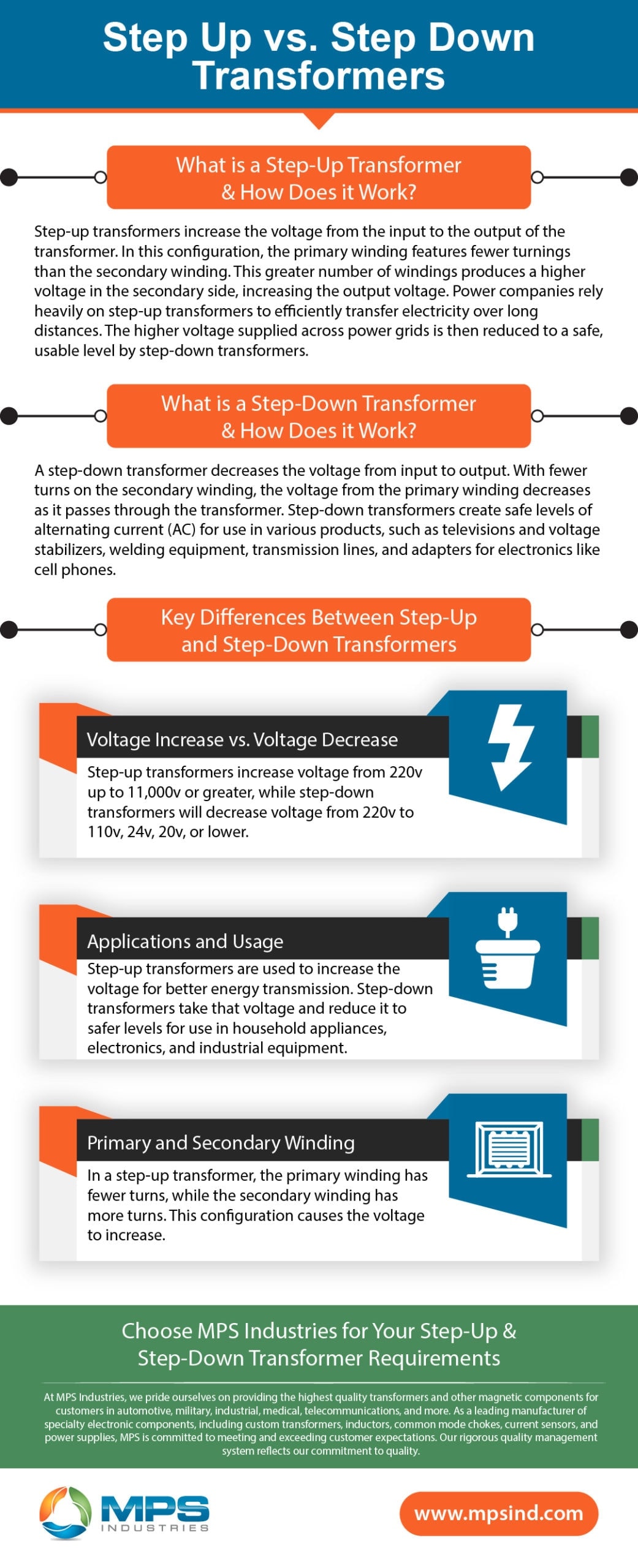A transformer is an electrical component composed of two or more wire coils that transmit and convert electrical energy through electromagnetic induction. Transformers can increase or decrease electrical voltage by transferring energy from an input coil (known as the primary winding) to one or more outputs (secondary windings). These windings consist of a magnetic core circuit — typically made of iron — and wrapped inside a coil of conductive copper wire.
The number of times the wire wraps around the core dictates the electrical current’s strength as it passes through the transformer. Voltage transmitted between the primary and secondary windings will step up (increase) or step down (decrease) depending on the number of turnings on each winding. This blog will provide a clear definition of step-up and step-down transformers and how they function.
What is a Step-Up Transformer? How Does a Step-Up Transformer Work?
Step-up transformers increase the voltage from the input to the output of the transformer. In this configuration, the primary winding features fewer turnings than the secondary winding. This greater number of windings produces a higher voltage in the secondary side, increasing the output voltage. Power companies rely heavily on step-up transformers to efficiently transfer electricity over long distances. The higher voltage supplied across power grids is then reduced to a safe, usable level by step-down transformers.
What is a Step-Down Transformer? How Does a Step-Down Transformer Work?
A step-down transformer decreases the voltage from input to output. With fewer turns on the secondary winding, the voltage from the primary winding decreases as it passes through the transformer. Step-down transformers create safe levels of alternating current (AC) for use in various products, such as televisions and voltage stabilizers, welding equipment, transmission lines, and adapters for electronics like cell phones.
Key Differences Between Step-Up and Step-Down Transformers
To summarize, step-up and step-down transformers operate under the same principles, but one increases electrical voltage while the other decreases it. The key differences include:
Voltage Increase vs. Voltage Decrease
Step-up transformers increase voltage from 220v up to 11,000v or greater, while step-down transformers will decrease voltage from 220v to 110v, 24v, 20v, or lower.
Applications and Usage
Power companies primarily use step-up transformers to increase the voltage for better energy transmission across the power grid. Step-down transformers take that voltage and reduce it to safer levels for use in household appliances, electronics, industrial equipment, and other applications.
Primary and Secondary Winding
In a step-up transformer, the primary winding has fewer turns, while the secondary winding has more turns. This configuration causes the voltage to increase. In a step-down transformer, the secondary winding has few turns, and the primary winding has more, causing the voltage to decrease as it passes through the transformer.
The primary winding of step-up transformers is often composed of thicker, insulated copper wire, and the secondary winding uses thinner wire of insulated copper. The opposite is true for step-down transformers, which use the thick insulated copper wire in the secondary winding instead. For both transformer types, the wire thickness is gauged based on the wire’s capacity and the intended current flow.
Choose Step-Up & Step-Down Transformers at MPS Industries
At MPS Industries, we pride ourselves on providing the highest quality transformers and other magnetic components for customers in automotive, military, industrial, medical, telecommunications, and more. As a leading manufacturer of specialty electronic components, including custom transformers, inductors, common mode chokes, current sensors, and power supplies, MPS is committed to meeting and exceeding customer expectations. Our rigorous quality management system reflects our commitment to quality.
In addition, we maintain numerous industry certifications, including:
- ISO 9001:2015
- ISO 14001:2015
- RoHS Compliance Statement
- REACH (Certificate of Compliance for specific products provided upon request)
- Conflict Minerals Compliance Statement
- ITAR Registered
- Joint Certification Program (JCP)
To learn more about our step-up and step-down transformers or any other products, please visit our product portfolio. Our solutions include high efficiency 50 Hertz (Hz)/60 Hertz (Hz) power transformers – you can find them here.
To see how we can help with your next project, please contact us or request a quote for your next project or reach out to our experts today.
